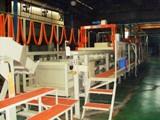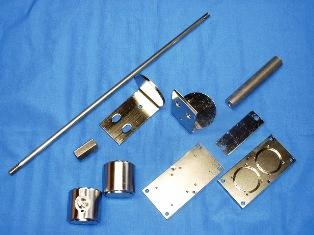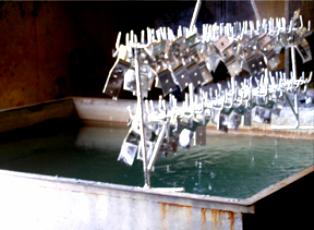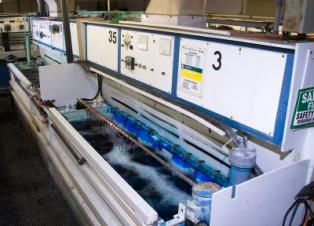Galvanizing and its application
 Galvanizing — a method of depositing metals on the surface of metal and non-metal products using electrolysis… After such deposition, the surface of the product acquires great corrosion resistance, more beautiful appearance (decorative coating), sometimes — greater hardness, wear resistance.
Galvanizing — a method of depositing metals on the surface of metal and non-metal products using electrolysis… After such deposition, the surface of the product acquires great corrosion resistance, more beautiful appearance (decorative coating), sometimes — greater hardness, wear resistance.
If in this case the product is covered with a very thin (5 — 30 μm) layer of metal, only in rare cases (surface hardening) reaching tenths of a millimeter, then this type of process is called galvanic coating.
At present, electroplating is widely used (copper plating, nickel plating, chrome plating, silver plating, gold plating, cadmium plating, zinc plating, tin plating, lead plating).
Gold plating, silver plating, nickel plating and chrome plating are mainly used for decorative purposes, while at the same time these coatings increase corrosion resistance.
Copper is mainly used as an interlayer on nickel or chrome steel products.The good adhesion of the protective metal to the material of the product is very important for the durability of the coatings..Zickel and chromium adhere tightly to the steel, therefore the latter is first softened, and then a layer of nickel or chromium is applied to the copper.
Since the chrome layer in some cases does not protect against corrosion, a three-layer coating (copper-nickel-chromium) is also used. Covering products with a layer of nickel or chromium protects the surface from oxidation when heated to 480 — 500 ° C. Zinc coating is widely used for corrosion protection; in some cases they resort to cadmium plating.
Chrome and nickel plating is also used to improve the wear resistance of surfaces, such as stereotypes in the printing industry. Covering a stereotype with a layer of nickel, chrome or iron can increase its service life by 10 or more times. In these cases, the thickness of the applied film should be greater (30-50 microns or more).
An irreplaceable condition for the adhesion strength of the applied layer to the base metal is the cleanliness of the latter's surface. Therefore, before electrolysis, the smallest traces of dirt, oxides, fats are carefully removed from the products. To do this, they are usually degreased in hot solutions of bases or in organic solvents — kerosene, gasoline.
To remove oxides and impurities, the products are etched in sulfuric or hydrochloric acid, and to obtain smooth surfaces - by grinding and polishing. The last operation is repeated after application, if for decorative reasons it is necessary to obtain a shiny surface, since bathroom products are usually matte.
The main part of the electrolyte is the salts of the deposited metal.In addition, to improve the conductivity of the electrolyte, acids or bases are often introduced into it, which make the electrolyte acidic or alkaline. During gilding and silver plating, and sometimes with copper plating, cyanide compounds are introduced into the electrolyte, which provides better adhesion of the coating to the base metal.alum.
As a rule, soluble anodes are used in electroplating processes in the form of strips or rods of metal applied to the cathode..V In this case, the metal is transferred from the anode to the cathode. However, anodes made of a metal or alloy that are insoluble in a given electrolyte are also used, for example, in chrome plating, made of lead or lead-antimony alloy. In this case, the metal is separated on the products due to the electrolyte and the salt of the applied metal must be systematically added to the electrolyte.
Galvanizing is carried out in baths made of a material that is chemically resistant to the electrolyte used. Large tubs are made of steel, welded, and for acid solutions they are insulated from the inside with rubber, ebonite, vinyl plastic or covered with acid-resistant and heat-resistant varnishes.
The workpieces to be processed are usually mounted on hangers in the bath. For processes taking place at a low current density (0.01 — 0.1 A / cm2), stationary baths with fixed cathodes are used.
At high current densities (e.g. in chrome plating) continuous baths are used, where the products during the coating process move from one edge of the bath to the other. Such baths are usually equipped with devices for mixing the electrolyte with compressed air and filtering it.
At high capacity, automatic machines equipped with a number of baths are used, in which not only the coating of the products themselves, but also their surface preparation (degreasing, etching and rinsing) is carried out. In such machines, the products, moving on steps horizontally and vertically, successively pass through all the tubs.
Electroplating, as with all electrolytic processes, uses direct current, usually low voltage (6 - 24 V). The process is regulated by changing the current density, the value of the latter changes depending on the process from hundredths and tenths of A / dm2 in gilding and silver to tenths of A / cm2 in chrome plating.
As the current density increases, the amount of deposited metal per unit time increases, but when it exceeds a certain value (its own for each process), the quality of the coating deteriorates sharply. Galvanized baths are powered by DC generators or semiconductor converters.
For most electroplating processes, the current efficiency is relatively high (from 100 to 90%), for a number of processes, for example, gilding and some types of copper plating, the current efficiency decreases to 70 - 60%. Only with chromium plating is very low (12%), since in this process most of the consumed electricity is spent on side reactions.
In recent years, experiments have been carried out on the use of alternating current in galvanic processes. Typically, an AC component is superimposed on a DC current, with the amplitude of the AC component being approximately 2 times the DC value.The use of alternating current in the production of nickel, copper and zinc coatings can improve their quality, in particular, reduce contamination of the applied layer with impurities.
In some cases, a copper coating is possible when the bath is supplied with a current of 50 Hz. This is explained by the partial rectification of the alternating current by an electrochemical cell, due to which a constant component appears in the bath current.



